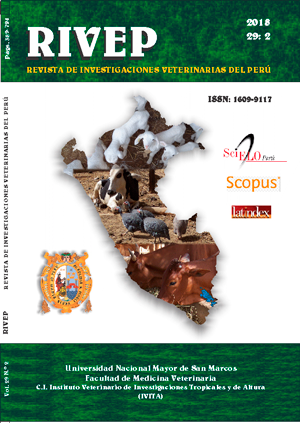Identification of opportunistic pathogenic bacteria in the uterus of alpaca pre and post-copula
DOI:
https://doi.org/10.15381/rivep.v29i2.14478Keywords:
alpaca, copulation, uterus, bacteriaAbstract
The aim of the present study was to identify bacteria present in the uterine mucosa of alpaca before and after the copula. Samples of uterine mucosa were taken (177 before and 60 after copulation). For the collection of the sample, metallic speculum and protected swabs were used to avoid sample contamination. The samples were conserved and transported to the laboratory in tubes with Stuart transport medium at 4 °C. Samples were cultured on blood agar and MacConkey agar at 37 °C for 24 h and bacterial identification was performed through biochemical tests. A total of 165 bacterial isolates and 29 yeasts in the pre-copula group and 64 bacterial isolates and 6 yeasts in the post-copula group were found. The bacteria most frequently isolated were E. coli (24.9%), Providencia stuartii (16.5%), Shigella sp (16.5%), Hafnia alvei (5.9%), Serratia rubidae (5.9%) and yeasts (14.8%).Downloads
Downloads
Published
Issue
Section
License
Copyright (c) 2018 Helen Dellepiane G., Siever Morales Cauti

This work is licensed under a Creative Commons Attribution-NonCommercial-ShareAlike 4.0 International License.
AUTHORS RETAIN THEIR RIGHTS:
a. Authors retain their trade mark rights and patent, and also on any process or procedure described in the article.
b. Authors retain their right to share, copy, distribute, perform and publicly communicate their article (eg, to place their article in an institutional repository or publish it in a book), with an acknowledgment of its initial publication in the Revista de Investigaciones Veterinarias del Perú (RIVEP).
c. Authors retain theirs right to make a subsequent publication of their work, to use the article or any part thereof (eg a compilation of his papers, lecture notes, thesis, or a book), always indicating the source of publication (the originator of the work, journal, volume, number and date).



